Abstract
The hypothesis that the many non-specific changes normally associated with cyclical ovarian activity are the primary aetiological factors in the premenstrual syndrome was tested by suppressing ovulation with subcutaneous oestradiol implants. Sixty eight women with proved premenstrual syndrome were treated under placebo controlled conditions for up to 10 months in a longitudinal study. Active treatment was combined with cyclical oral norethisterone to produce regular withdrawal periods. Symptoms were monitored with daily menstrual distress questionnaires, visual analogue scales, and the 60 item general health questionnaire. Of the 35 women treated with placebo 33 improved, giving an initial placebo response rate of 94%. The placebo effect gradually waned, but the response to the active combination was maintained for the duration of the study. Analysis of the prospective symptom ratings showed a significant superiority of oestradiol implants over placebo after two months for all six symptom clusters in the menstrual distress questionnaire. Changes seen in the retrospective assessments were less significant but the trend was the same. Treatment with oestradiol implants and cyclical progestogen was well tolerated and appears to be both rational and effective for severe cases of the premenstrual syndrome.
Full text
PDF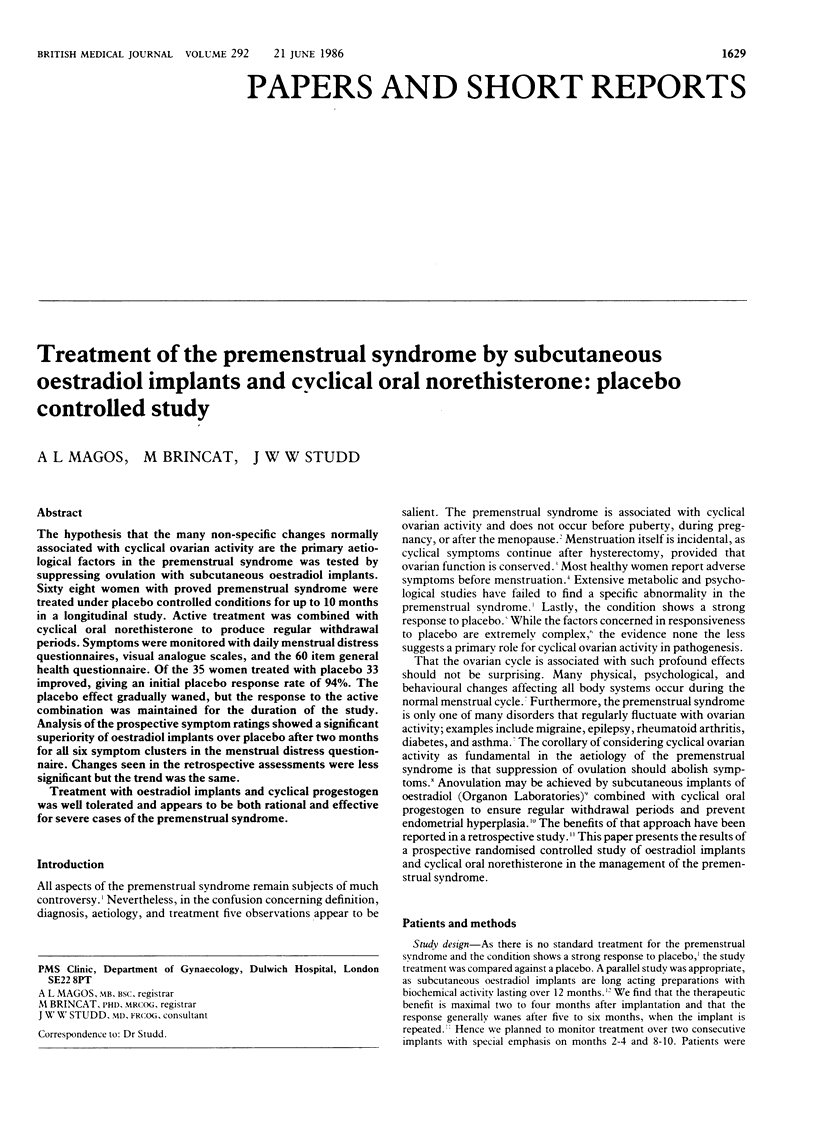
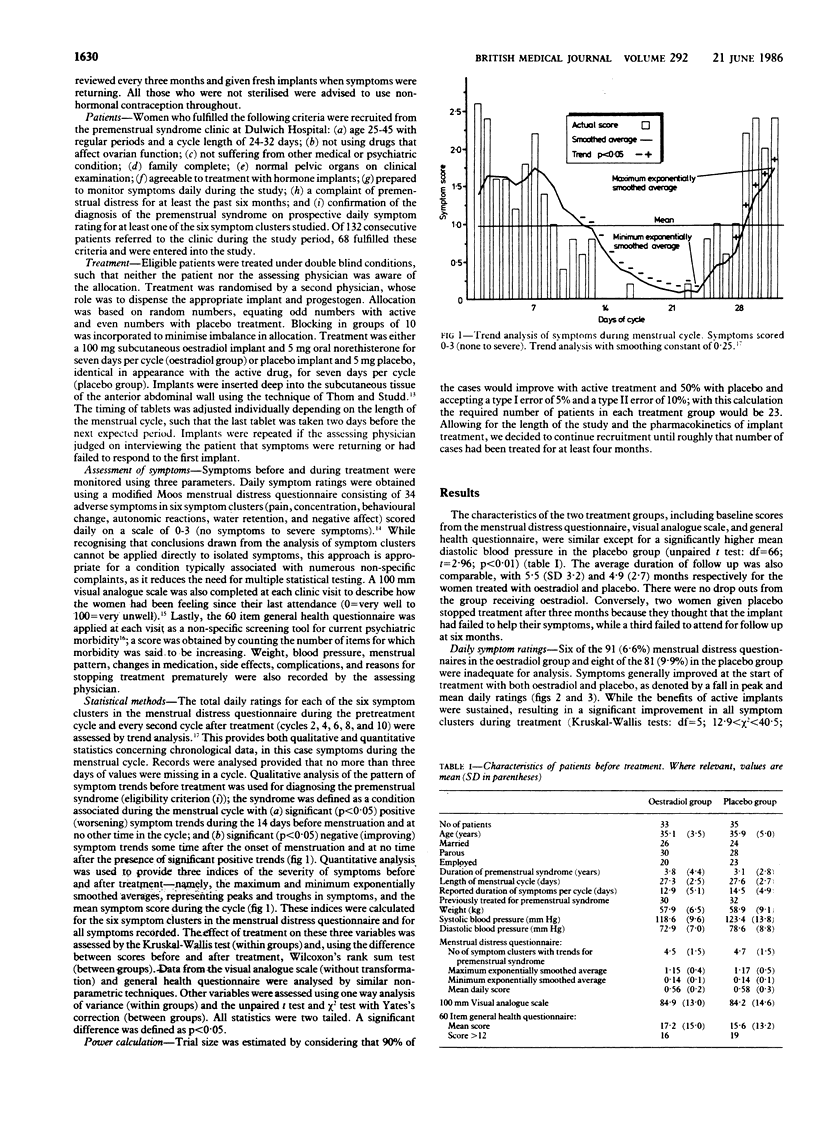
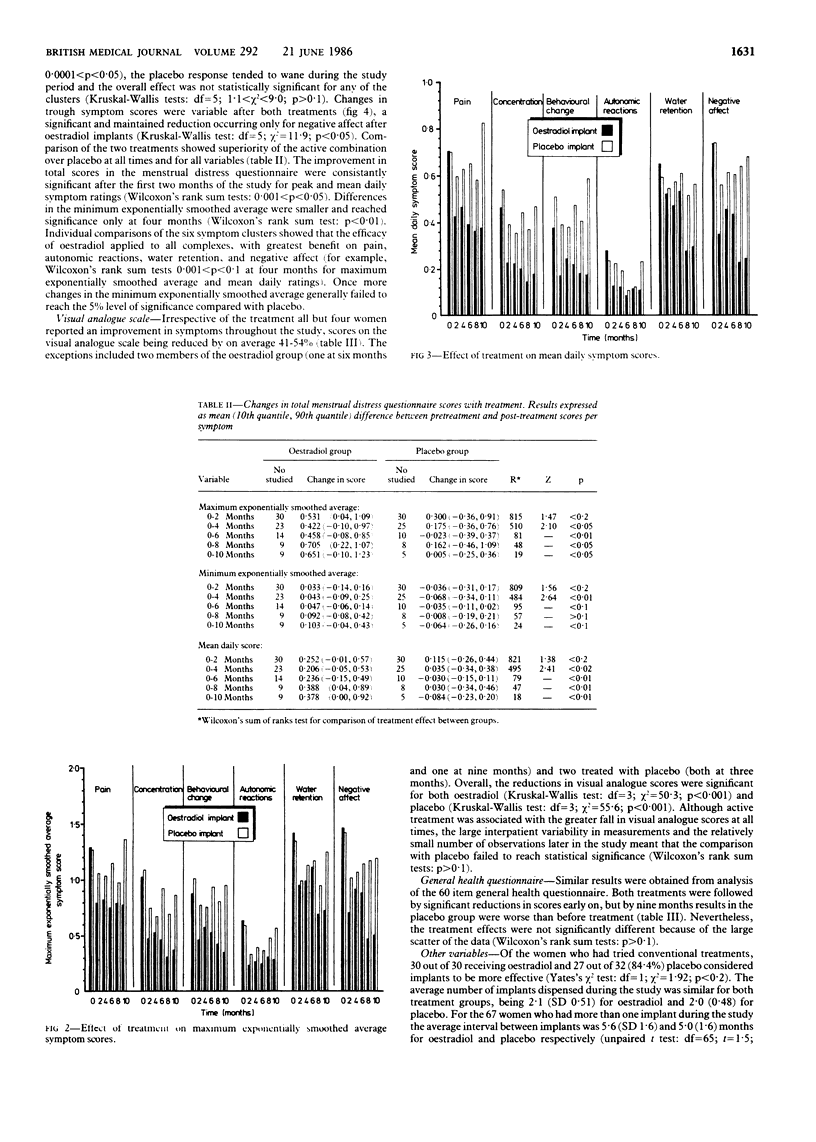
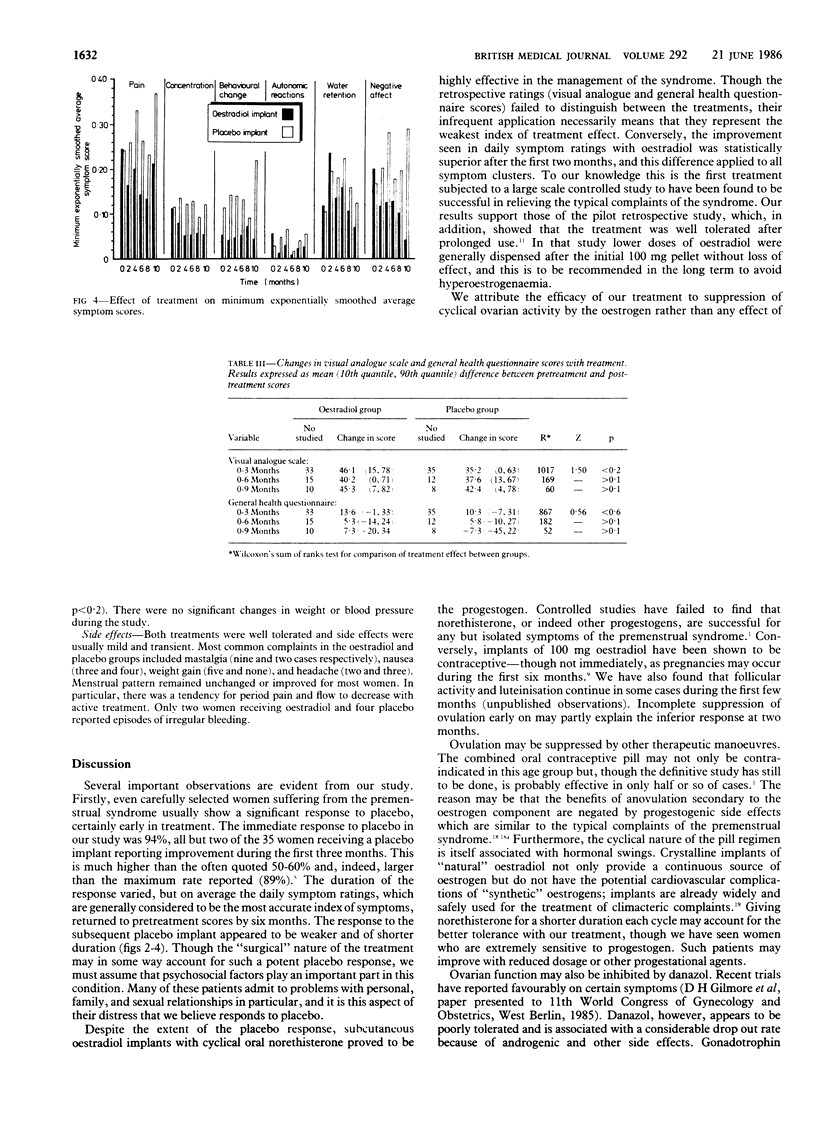
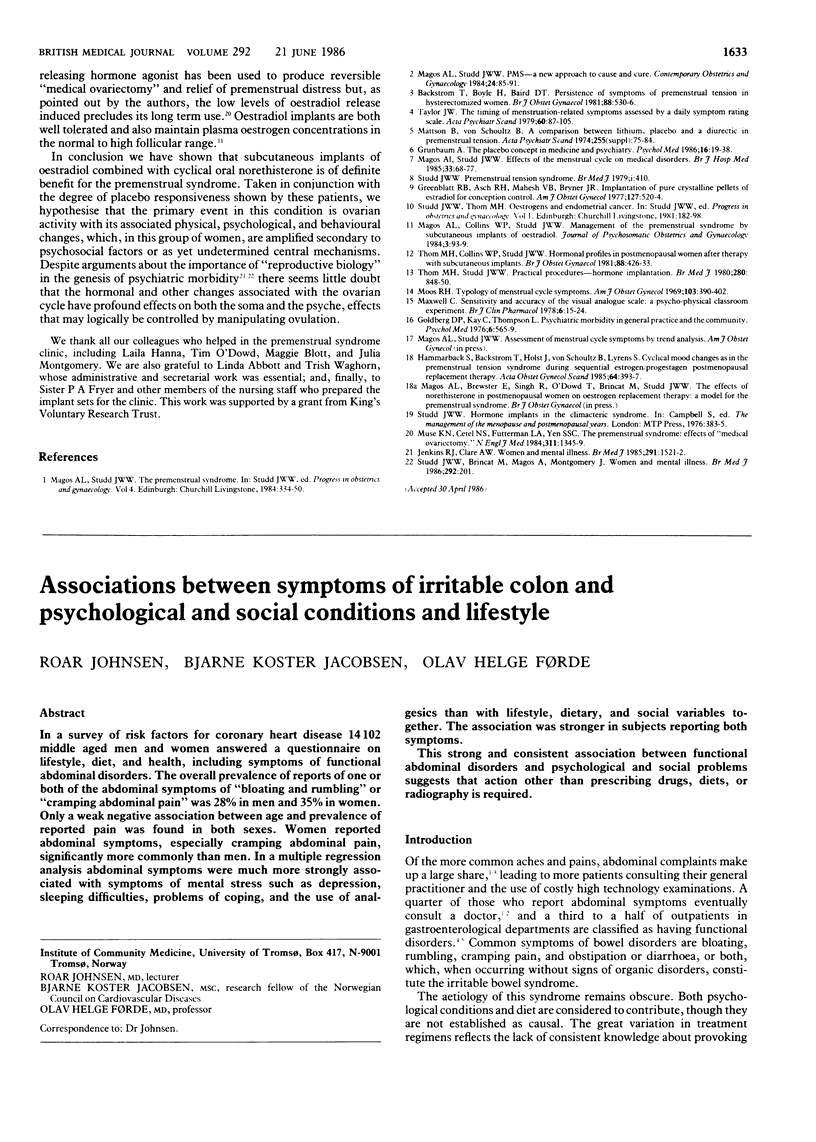
Selected References
These references are in PubMed. This may not be the complete list of references from this article.
- Bäckström C. T., Boyle H., Baird D. T. Persistence of symptoms of premenstrual tension in hysterectomized women. Br J Obstet Gynaecol. 1981 May;88(5):530–536. doi: 10.1111/j.1471-0528.1981.tb01028.x. [DOI] [PubMed] [Google Scholar]
- Goldberg D., Kay C., Thompson L. Psychiatric morbidity in general practice and the community. Psychol Med. 1976 Nov;6(4):565–569. doi: 10.1017/s0033291700018183. [DOI] [PubMed] [Google Scholar]
- Greenblatt R. B., Asch R. H., Mahesh V. B., Bryner J. R. Implantation of pure crystalline pellets of estradiol for conception control. Am J Obstet Gynecol. 1977 Mar 1;127(5):520–524. doi: 10.1016/0002-9378(77)90447-1. [DOI] [PubMed] [Google Scholar]
- Grünbaum A. The placebo concept in medicine and psychiatry. Psychol Med. 1986 Feb;16(1):19–38. doi: 10.1017/s0033291700002506. [DOI] [PubMed] [Google Scholar]
- Hammarbäck S., Bäckström T., Holst J., von Schoultz B., Lyrenäs S. Cyclical mood changes as in the premenstrual tension syndrome during sequential estrogen-progestagen postmenopausal replacement therapy. Acta Obstet Gynecol Scand. 1985;64(5):393–397. doi: 10.3109/00016348509155154. [DOI] [PubMed] [Google Scholar]
- Jenkins R., Clare A. W. Women and mental illness. Br Med J (Clin Res Ed) 1985 Nov 30;291(6508):1521–1522. doi: 10.1136/bmj.291.6508.1521. [DOI] [PMC free article] [PubMed] [Google Scholar]
- Magos A., Studd J. Effects of the menstrual cycle on medical disorders. Br J Hosp Med. 1985 Feb;33(2):68–77. [PubMed] [Google Scholar]
- Mattsson B., von Schoultz B. A comparison between lithium, placebo and a diuretic in premenstrual tension. Acta Psychiatr Scand Suppl. 1974;255:75–84. doi: 10.1111/j.1600-0447.1974.tb08896.x. [DOI] [PubMed] [Google Scholar]
- Maxwell C. Sensitivity and accuracy of the visual analogue scale: a psycho-physical classroom experiment. Br J Clin Pharmacol. 1978 Jul;6(1):15–24. doi: 10.1111/j.1365-2125.1978.tb01676.x. [DOI] [PMC free article] [PubMed] [Google Scholar]
- Moos R. H. Typology of menstrual cycle symptoms. Am J Obstet Gynecol. 1969 Feb 1;103(3):390–402. doi: 10.1016/0002-9378(69)90499-2. [DOI] [PubMed] [Google Scholar]
- Muse K. N., Cetel N. S., Futterman L. A., Yen S. C. The premenstrual syndrome. Effects of "medical ovariectomy". N Engl J Med. 1984 Nov 22;311(21):1345–1349. doi: 10.1056/NEJM198411223112104. [DOI] [PubMed] [Google Scholar]
- Taylor J. W. The timing of menstruation-related symptoms assessed by a daily symptom rating scale. Acta Psychiatr Scand. 1979 Jul;60(1):87–105. doi: 10.1111/j.1600-0447.1979.tb00268.x. [DOI] [PubMed] [Google Scholar]
- Thom M. H., Collins W. P., Studd J. W. Hormonal profiles in postmenopausal women after therapy with subcutaneous implants. Br J Obstet Gynaecol. 1981 Apr;88(4):426–433. doi: 10.1111/j.1471-0528.1981.tb01008.x. [DOI] [PubMed] [Google Scholar]
- Thom M. H., Studd J. W. Procedures in practice. Hormone implantation. Br Med J. 1980 Mar 22;280(6217):848–850. doi: 10.1136/bmj.280.6217.848. [DOI] [PMC free article] [PubMed] [Google Scholar]
- Women and mental illness. Br Med J (Clin Res Ed) 1986 Jan 18;292(6514):201–202. doi: 10.1136/bmj.292.6514.201. [DOI] [PMC free article] [PubMed] [Google Scholar]


